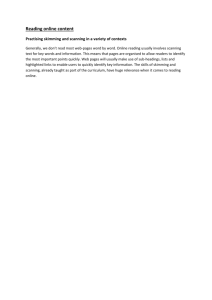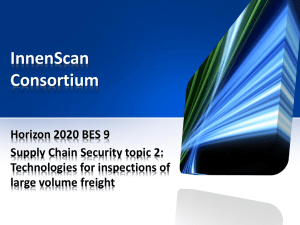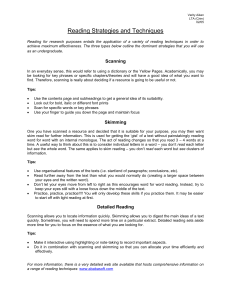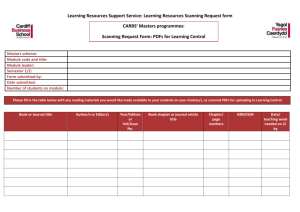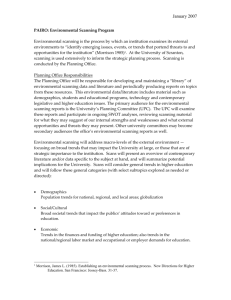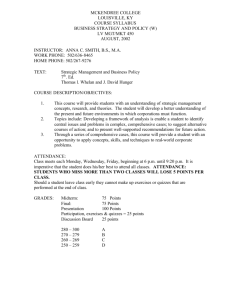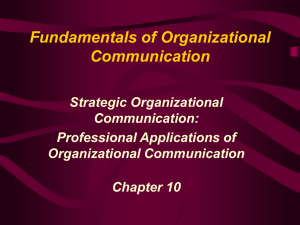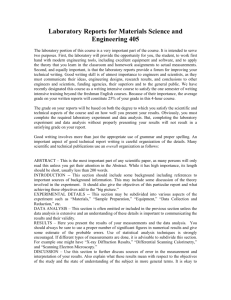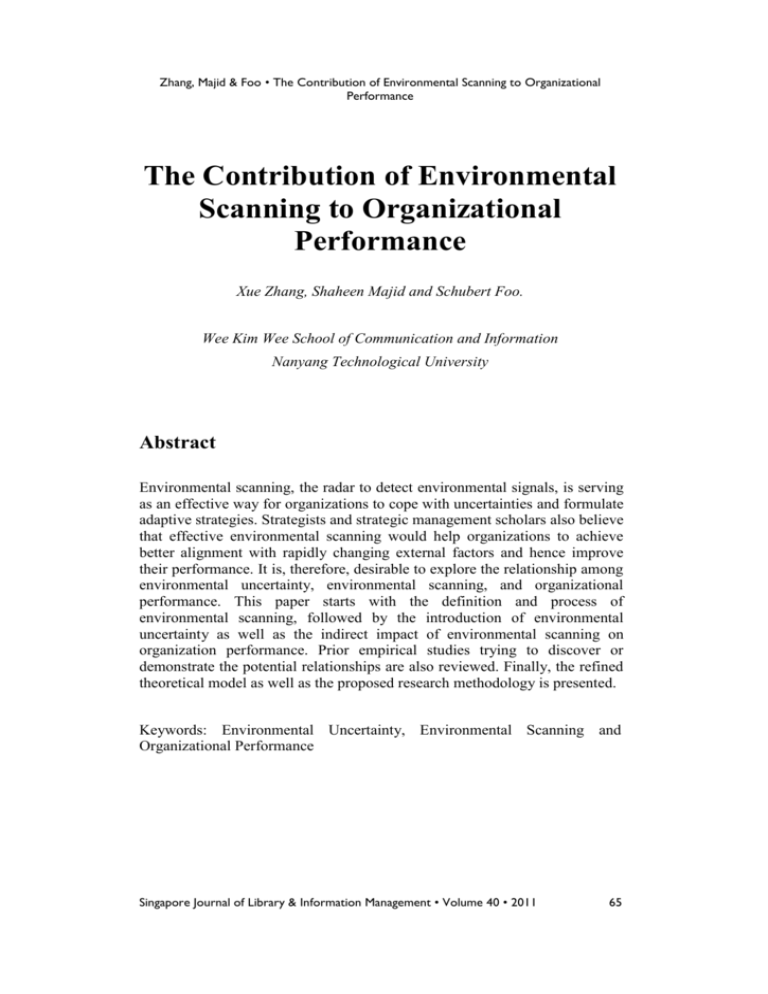
Zhang, Majid & Foo • The Contribution of Environmental Scanning to Organizational
Performance
The Contribution of Environmental
Scanning to Organizational
Performance
Xue Zhang, Shaheen Majid and Schubert Foo.
Wee Kim Wee School of Communication and Information
Nanyang Technological University
Abstract
Environmental scanning, the radar to detect environmental signals, is serving
as an effective way for organizations to cope with uncertainties and formulate
adaptive strategies. Strategists and strategic management scholars also believe
that effective environmental scanning would help organizations to achieve
better alignment with rapidly changing external factors and hence improve
their performance. It is, therefore, desirable to explore the relationship among
environmental uncertainty, environmental scanning, and organizational
performance. This paper starts with the definition and process of
environmental scanning, followed by the introduction of environmental
uncertainty as well as the indirect impact of environmental scanning on
organization performance. Prior empirical studies trying to discover or
demonstrate the potential relationships are also reviewed. Finally, the refined
theoretical model as well as the proposed research methodology is presented.
Keywords: Environmental Uncertainty, Environmental Scanning and
Organizational Performance
Singapore Journal of Library & Information Management • Volume 40 • 2011
65
Zhang, Majid & Foo • The Contribution of Environmental Scanning to Organizational
Performance
Introduction
Organisations today are facing unprecedented challenges in
maintaining commercial survival and success. Due to the rapid changes
happening in today’s marketplace and emerging business practices, it is more
likely for an organisation, to fall behind by not keeping up with trends of
their external environments (Albright, 2004). On the one hand, numerous
companies went out of business simply because a change happened in their
business environment to which they failed to respond quickly and
appropriately. On the other hand, actively detecting environmental signals
and immediately grasping opportunities or countering threats can lead firms
to success and prosperity. Environmental scanning, serving as “the first link
in the chain of perceptions and actions that permit an organization to adapt to
its environment” (Hambrick, 1981; Jennings & Lumpkin, 1992), has become
an important aspect of strategic management for coping with environmental
uncertainties, and the impact of environmental scanning to organizational
performance has been receiving more and more attention among scholars.
Environmental scanning is a systematic process starts from scanning
needs identification and ends at evaluation and utilization of environmental
information. With the term coined in the late 1960s, environmental scanning
is still an emerging discipline, with explorative studies conducted in various
organisations. In light of the changes and developments, it has become
imperative for organisations to scan their environments continuously and
systematically with all the phases being studied as a whole. However, in prior
literature, besides information acquisition, insufficient attention has been paid
to the other steps of environmental scanning. Moreover, for studies
attempting to discover or demonstrate the association between environmental
scanning and organizational performance, the majority of them chose to
measure organization’s financial performance only, such as profitability,
return on capital and net profit margin, while neglecting the other aspects as
customer satisfaction, operation efficiency and organization growth. As a
result, there is a need to develop a refined model presenting a clearly defined
environmental scanning process, paying equal attention to all its steps while
investigating the impact of environmental uncertainty, and showing the
indirect contribution of environmental scanning on organizational
performance other than merely from the final perspective.
Singapore Journal of Library & Information Management • Volume 40 • 2011
66
Zhang, Majid & Foo • The Contribution of Environmental Scanning to Organizational
Performance
Definition and Process of Environmental Scanning
In the field of environmental scanning, the first notable study was
carried out by Aguilar (1967). Aguilar defines environmental scanning as
acquiring information about events and relationships in a company’s outside
environment, the knowledge of which would assist top management in its
task of charting the company’s future course of action. Based on this
definition, organisations scan the environment in order to get a strategic
understanding of external influences so that they may be able to develop
effective response that secures or adjusts their position in the future.
Subsequent studies reinforced Aguilar’s definition without
substantially altering this perspective; however, the process of environmental
scanning was gradually extended and has been conceptualized as an
integrated information management system. Aaker (1983) pointed out that
environmental scanning should focus on target information needs, allocate
effort among employees exposed to relevant information, and have an
effective system for storing, processing and disseminating information.
According to Daft and Weick (1984), the way an organisation deciphers its
environment in order to learn from it may be divided into three phases:
scanning (information seeking), interpretation (giving meaning to the
collected data) and learning (taking action based on the data). Similarly,
Lester and Waters (1989) define environmental scanning as a management
process of using information from the environment to aid decision-making
with three key components: obtaining the information, analyzing the
information and using the information. These definitions highlight the
consequent steps after information acquisition. Based on the foundation of
Aaker (1983), Costa (1995) proposes a strategic information scanning system
which consists of six steps, in order to preserve much of the information
which is invariably lost in many organisations, and hence enhance the
effectiveness of these scanning efforts. Steps one and two of his proposed
system specify information needs and sources; steps three and four identify
the participants of the system and assign them scanning tasks; and steps five
and six deal with the storage, processing and dissemination of the
information (Costa, 1995). Albright (2004) raises five integrally linked steps
by omitting information organisation and storage. Similarly, Hough and
White (2004) view environment scanning as a process of identifying,
collecting, processing and translating information about external influences
into useful plans and decisions.
Singapore Journal of Library & Information Management • Volume 40 • 2011
67
Zhang, Majid & Foo • The Contribution of Environmental Scanning to Organizational
Performance
External Environment and Uncertainty
The external environment refers to the relevant social and physical
factors outside the typical boundaries of an organisation which affect
managerial decision-making (McGee & Sawyerr, 2003; Sawyerr, 1993).
Broadly, the external environment can be divided into two categories: the
task or domain environment which has a direct impact on company tasks and
outcomes and the remote environment with indirect and long-term impacts
(Carpenter & Sanders, 2009; Dill, 1958; Hall, 1982; Myburgh, 2004; Sawyerr,
1993). Specifically, the task environment, commonly recognized as more
significant, includes customers, suppliers (resources), competitors and other
stakeholders, while the remote environment broadly consists of six sectors,
i.e. political, economic, social-cultural, technological environmental and legal
sectors (Dill, 1958; Hall, 1982; Myburgh, 2004; Sawyerr, 1993). Task
environment is organisation-specific, i.e. each organisation operates in its
unique task environment. However, companies operating in the same
industry domain may have similar task environment, if they choose the same
target market or the same group of suppliers; at the same time, they would
become part of the task environment for each other as one of the competitors
(Organization A and B in Figure 1).
Figure 1: The External Environment
Singapore Journal of Library & Information Management • Volume 40 • 2011
68
Zhang, Majid & Foo • The Contribution of Environmental Scanning to Organizational
Performance
Environmental uncertainty has long been viewed as a central concept
in the organization theory literature, particularly in theories seeking to
explain the nature of the relationship between organizations and their
environments (Buchko, 1994; Milliken, 1987). Pioneer studies on
environmental uncertainty either measure it “objectively” (Tinker, 1976) or
“perceptually” (Child, 1972; Downey & Slocum, 1975). However, as
environmental issues are often ambiguous and require interpretation for issue
diagnosis, perceptions are critical in guiding decision making (Boyd, Dess, &
Rasheed, 1993; Daft & Weick, 1984). Hence, perceived environmental
uncertainty has more influence on scanning than objective environmental
conditions.
Perceived environmental uncertainty occurs when administrators
perceive unpredictability of an organization’s environment (Buchko, 1994;
Milliken, 1987). It is the difference between available information and
derived information (Daft, Sormunen, & Parks, 1988; Galbraith, 1977). In
other words, decision-makers perceive uncertainty of the environment when
they do not feel confident that they understand the major events or trends
happening in the external environment, or when they feel unable to
accurately assign probabilities to the likelihood that particular events and/or
changes will occur (Milliken, 1987). Specifically, two environmental
characteristics, degree of complexity and rate of change, influence perceived
environmental uncertainty (Duncan, 1972; Robbins & Coulter, 2005). Degree
of complexity refers to the number of external components that are relevant
to the organization (Child, 1972; Duncan, 1972; Robbins & Coulter, 2005),
while rate of change refers to the frequency of changes that occurs in the
organization’s external environment (Duncan, 1972; Robbins & Coulter,
2005).
Daft et al. (1988) further proposed that scanning was affected more
when perceived environmental uncertainty was located in strategically
important sectors. They noted that uncertainty by itself will not lead to
scanning behaviour, unless the external components are perceived as
important to organizational performance. The combination of perceived
environmental uncertainty and strategic importance creates “perceived
strategic uncertainty” (PSU) for decision-makers, and is expected to generate
a need for them to conduct scanning for the selected environmental sectors
(Daft et al., 1988).
Singapore Journal of Library & Information Management • Volume 40 • 2011
69
Zhang, Majid & Foo • The Contribution of Environmental Scanning to Organizational
Performance
Environmental
Performance
Scanning
and
Organizational
It would not be accurate to claim that environmental scanning would
lead directly to better organizational performance, as performance would be
influenced through a combination of various factors (Daft et al., 1988).
However, a careful tailoring of scanning to strategic intent does provide input
for incremental environment-strategy fit (Kumar, Subramanian, &
Strandholm, 2001). Effective scanning underlies the sound executive choices
and judgment that are essential for strategic success (Child, 1972, 1997; Garg,
Walters, & Priem, 2003), as it would be able to provide a company industry
foresight and the potential to get to the future before the competitors thereby
obtaining a leadership position in the market place (Hamel & Prahalad, 1994).
Empirical studies also suggest that scanning has value associated with faster
reaction times, higher growth rates, enhancement of firms’ knowledge base
and their effective planning horizon (Stoffels, 1994). Therefore, organizations
conducting effective environmental scanning activities would be more likely
to cope with threats and grasp opportunities, and hence obtain sustainable
competitive advantages. The “fit” between organizations and their
environments is proposed to be the most significant predictor of
organizational survival and performance (Boyd & Fulk, 1996), while
environmental scanning is the most effective way to achieve such alignment.
Specifically, with effective scanning, organizations would be able to
obtain more accurate market and industry insights, and hence more likely to
satisfy current customers and explore new market segments, successfully
develop and market new products/services based on trend analysis (Ahituv,
Zif, & Machlin, 1998; Kohn, 2005), establish better brand images, all of
which would ultimately contribute to the financial performance. Moreover,
environmental scanning has been found to be useful for reducing
environmental uncertainty and assisting in companies’ risk management.
With sufficient environmental intelligence, organizations would be able to
manage strategic surprise and response quickly even to weak signals (Ansoff,
1975).
Prior Empirical Studies
Theoretically, perceived strategic uncertainty will trigger the need for
scanning (Daft et al., 1988; Elenkov, 1997a). Strategists and strategic
management scholars generally agree that both large and small firms that
align their business strategies with their respective environments are likely to
Singapore Journal of Library & Information Management • Volume 40 • 2011
70
Zhang, Majid & Foo • The Contribution of Environmental Scanning to Organizational
Performance
outperform firms that fail to achieve such alignment (Venkatraman &
Prescott, 1990). In prior literature, a number of studies attempted to discover
or demonstrate the association between environmental uncertainty,
environmental scanning and organisational performance, for both large and
small firms, for-profit and non-profit organisations as follows.
Adopted Measurements
Measurement of Environmental Uncertainty
The most widely adopted method in prior studies for measuring
environmental uncertainty is PSU = PI× (C+R), where PSU =
perceived strategic uncertainty; PI = perceived sector importance;
C+R = perceived sector uncertainty; C = the perceived sector
complexity; R = the perceived sector rate of change (Ahituv et al.,
1998; Auster & Choo, 1993; Daft et al., 1988; Ebrahimi, 2000; May,
Stewart, & Sweo, 2000; Sawyerr, 1993; Stewart, May, & Kalia, 2008).
Researchers used this formula to measure the perceived strategic
uncertainty of various environmental sectors respectively, and the
results were averaged to obtain the perceived strategic uncertainty for
both remote environment and task environment. Boynton, Gales and
Blackburn (1993) measured uncertainty through two dimensions,
AVAIL (the availability of needed information) and PREDICT (the
predictability of future outcomes); Olsen, Murthy and Teare (1994)
required study participants to rate the uncertainty of their firm’s
environment on a continuum ranging from stable to volatile; Boyd
and Fulk (1996) investigated two dimensions of uncertainty as
strategic variability (an event’s variability multiplied by its strategic
importance) and complexity (analyzability, predictability and
adequacy of information); Elenkov (1997b) used a revised formula,
which is SU = EU × I, where SU = perceived strategic uncertainty;
EU = perceived environmental uncertainty (degree of predictability
for various characteristics of the environmental sectors); I = perceived
sector importance; Hough and White (2004) asked participants to
report the uncertainty by 3 levels (dynamic, moderate and stable).
Measurement of Environmental Scanning
The frequency of scanning (frequency of collecting information about
each environmental sector) and the degree of interest (the degree to
which the executives made it a point to stay abreast of information
from each sector) were the most widely used two dimensions for
measuring ES. These two dimensions were firstly used by Hambrick
(1982). However, these two dimensions were measured differently by
different researchers. The frequency of scanning could be measured
through a Likert scale ranging from seldom to regularly (Ebrahimi,
Singapore Journal of Library & Information Management • Volume 40 • 2011
71
Zhang, Majid & Foo • The Contribution of Environmental Scanning to Organizational
Performance
2000; Elenkov, 1997a; Elenkov, 1997b; Strandholm & Kumar, 2003)
or on a 5 or 6 point scale with a range from never (0) to daily (365)
(McGee & Sawyerr, 2003; Sawyerr, 1992; Sawyerr, 1993). The
degree of interest was measured on a 5 or 7 point ordinal scale from
very low to very high (Boyd & Fulk, 1996; Ebrahimi, 2000; McGee
& Sawyerr, 2003; Sawyerr, 1992; Sawyerr, 1993). Besides these two,
other covered dimensions of ES include scope of scanning (Beal,
2000; Strandholm & Kumar, 2003), use/accessibility of information
sources (May et al., 2000; Ngamkroeckjoti & Speece, 2008; Stewart
et al., 2008), scanning completeness measured by number of
information bits known at end divided by number of information bits
available (Hough & White, 2004), time spent on scanning (Boynton et
al., 1993), type of scanning system (Primitive, ad hoc, reactive and
proactive) (Subramanian, Fernandes, & Harper, 1993), type and role
of scanning unit (Olsen et al., 1994) and scanning function
(Subramanian et al., 1993).
Measurement of Organisational Performance
Since the late 1980s, researchers have started to demonstrate the
contribution of ES to organisational performance. The most adopted
measures are about financial performance, such as profitability (return
on assets), return on sales, growth in sales (Ahituv et al., 1998; Brush,
1992; Daft et al., 1988; McGee & Sawyerr, 2003; Olsen et al., 1994;
Subramanian et al., 1993; West, 1988). Some researchers used
subjective approach through self-reporting measures. Kumar et al.
(2001) asked participants for their assessment of their organisation’s
performance on various measures. Similarly, Garg et al. (2003)
required the CEOs to report their best subjective estimates of
performance compared to similar firms in their industry on a 5-point
scale for after tax return on total sales/assets, sales growth and overall
performance/success. Beal (2000) required participants to scale six
financial performance indicators, including measures of profitability,
growth and total amount of profits, based on their perceived
importance and satisfaction.
It is worth noting that besides the financial measures, other aspects of
organisational performance, such as customer satisfaction, operation
efficiency, employee satisfaction, are not equally treated as important.
Very limited studies have paid attention to these measures.
Strandholm and Kumar (2003) included efficiency (per
employee/patient expenditure) and effectiveness (capacity utilization
of hospital facilities) as performance measures while investigating
hospitals’ environmental scanning activities. Ngamkroeckjoti and
Singapore Journal of Library & Information Management • Volume 40 • 2011
72
Zhang, Majid & Foo • The Contribution of Environmental Scanning to Organizational
Performance
Speece (2008) used customer acceptance as one factor to evaluate
new product performance.
Discovered Relationships
Environmental Uncertainty and Scanning
To investigate the relationship between environmental uncertainty and
scanning mode, Daft et al. (1988) interviewed chief executives of 50
manufacturing companies and concluded that the managers respond to
higher strategic uncertainty by using human sources somewhat more
often than written sources. Through personal interviews with
executives in 141 medium-size Bulgarian companies, Elenkov (1997a)
also discovered that the higher the uncertainty in the domain
environment, the more frequently decision-makers in Bulgarian
companies relied on personal modes of scanning, i.e. scanning
through direct human contact.
Regarding the relationship between environmental uncertainty and
frequency of scanning, researchers tend to hold different views based
on the results of their studies. Some researchers suggest a linear
relationship where increased uncertainty would lead to increased
scanning frequency (McGee & Sawyerr, 2003; Sawyerr, 1993). The
study conducted by Ebrahimi (2000) partially supports the linear
relationship, as it is discovered that greater perceived strategic
uncertainty resulting in higher degree of interest is only true for task
and remote environment, but not for external environment as a whole.
Conversely, Elenkov (1997a) failed to provide evidence of a positive
relationship between strategic uncertainty and frequency of scanning.
Moreover, a recent study conducted among SMEs in Singapore
showed that if overall general environment is dynamic and uncertain,
even organisations in relatively stable industries also feel the need for
active ES (Majid & Kowtha, 2008).
Instead of proposing a simple linear relationship between the two,
some researchers discovered more complex relationships. Choo (1993)
found that the use frequency of various information sources is
positively correlated with perceived source accessibility, perceived
source quality and perceived environmental uncertainty, and
perceived source quality accounts for the most of the variance of the
frequency of the source use. Similarly, Stewart and Sweo (2000)
reported that strategic uncertainty was moderated by perceptions of
accessibility in determining scanning frequency. Boynton, Gales and
Blackburn (1993) proposed an inverted U-shape relationship, arguing
that scanning increases as environmental uncertainty increases and
then reaches a threshold where the uncertainty becomes so
Singapore Journal of Library & Information Management • Volume 40 • 2011
73
Zhang, Majid & Foo • The Contribution of Environmental Scanning to Organizational
Performance
overwhelming that scanning frequency decreases. However, the
results turned out to be just opposite their hypothesis: the highest
levels of information search activity took place where uncertainty was
either low or high while at intermediate levels of uncertainty
managers engage in significantly less search activity.
Environmental Scanning and Organisational Performance
Correlation analysis was used in prior studies to identify the impact of
environmental scanning to organisational performance through
financial measures. Some researchers successfully demonstrated that
better environmental scanning (more frequent/broader collection of
environmental information or more advanced scanning system) would
result in better organisational performance (Garg et al., 2003;
Strandholm & Kumar, 2003; Subramanian et al., 1993; Subramanian,
Kumar, & Yauger, 1994; West, 1988). There are also some studies
failed to establish a link between the two. Based on the analysis
results of a survey conducted by Brush (1992), few highly significant
correlations were found between performance variables and type of
marketplace information, methods or sources. Sawyerr et al. (2000)
examined use of information sources, ES practices and organisational
performance of 47 small to medium-sized manufacturing firms in
Nigeria. It was discovered that scanning frequency did not appear to
affect organisational financial performance as measured by selfreported return on equity and profit margin. They suspected that the
missing link may probably be due to the absence of actual
performance data. Beal (2000) also concluded that the frequency of
scanning has no effect on the alignment between competitive
strategies and environments and hence organisational performance.
According to Beal (2000), the unexpected result may probably be
caused by the uncontrolled factors like industry and firm size, etc.
Environmental
Performance
Uncertainty,
Scanning
and
Organisational
There are also a few studies investigating the relationship among the
three. Daft, Sormunen and Parks (1988) concluded that when sector
uncertainty was high, executives reported greater frequency of
scanning and greater use of personal information sources. Moreover,
chief executives in high-performing companies scanned more
frequently and more broadly in response to strategic uncertainty than
their counterparts in low performing companies. Ahituv, Zif and
Machlin (1998) discovered that firms succeeding better with new
products will show a greater correlation between strategic uncertainty
and frequency of scanning of the technological, economic and socio-
Singapore Journal of Library & Information Management • Volume 40 • 2011
74
Zhang, Majid & Foo • The Contribution of Environmental Scanning to Organizational
Performance
cultural sectors, and more successful firms will exhibit more frequent
formal scanning in the task environment. The study conducted by
Olsen, Murthy and Teare (1994) demonstrated that hotels with higher
growth in sales showed greater interest in customer-related issues,
and hotels with higher growth in income and rooms showed greater
interest in demographic changes, competitor offerings and new
technological developments.
Toward a Refined Model of Environmental Scanning
Based on the literature review, a model representing the relationship
among perceived strategic uncertainty, environmental scanning and
organizational performance is proposed, with consideration of some
additional factors (Figure 2). It shows that organizations’ internal activities
Figure 2: Relationship Model of Perceived Strategic Uncertainty,
Environmental Scanning and Organisational Performance
are directed by organization knowledge and influenced by their external
environments, both remote and task environments. Organization knowledge
Singapore Journal of Library & Information Management • Volume 40 • 2011
75
Zhang, Majid & Foo • The Contribution of Environmental Scanning to Organizational
Performance
includes explicit knowledge (e.g. operation routines, organization regulations,
minutes and various kinds of reports), and tacit knowledge of both employees
and decision-makers, as well as the cultural knowledge known as shared
assumptions and beliefs. Organization knowledge and the information/
knowledge system for collecting, storing, processing, disseminating and
sharing information/ knowledge comprise organizational knowledge
repository. This repository may take the form of a formal computer-based
information system or other more rudimentary system like storing
information in paper files, sharing information through informal conversation
over lunch, etc. When the existing organisational knowledge cannot interpret
or understand the signals from external environments, organisations perceive
it as uncertainty. If the uncertainty occurs in the environmental sectors with
strategic importance, it would generate scanning needs which require
organisations to actively collect more information about their external
environments to help understand the emerging trends, and hence reduce risks
or threats and detect potential opportunities.
Through the whole process of environmental scanning, the final
outcome of environmental scanning, as newly formulated insights about the
external environments, would automatically become part of the
organisational knowledge and assist in strategy formulation. If the formulated
strategy is well-implemented, it could help an organisation to achieve
alignment with its external environments, in terms of grasping opportunities
and overcoming threats. As a result, the organisation is likely to gain
competitive advantage, achieve strategy-environment alignment, and hence
improve the chance of achieving better organisational performance. Some
organisational factors, such as age and size, according to prior studies
(Mohan-Neill, 1995; Strandholm & Kumar, 2003), may have certain
moderating effects on the whole process.
The proposed model addresses the common limitations shared by
prior empirical studies. The first limitation is regarding the variables used to
measure scanning activities. As environmental scanning is defined as a
systematic process starting with information needs identification and ending
with the environmental information ready for tactical and strategic usage, all
the steps may have influences on its ultimate effectiveness and efficiency.
The majority or nearly all of the previous studies investigating scanning
process have mainly focused on the phase of information collection with
some easily measurable variables such as frequency of scanning, use of
different kinds of information sources (personal and non-personal, internal
and external) and scanned environmental sectors, while neglecting the other
activities such as needs identification, information processing, organizing,
dissemination and utilization. It is possible that some organizations do well in
information collection but poorly in processing and dissemination. As such,
Singapore Journal of Library & Information Management • Volume 40 • 2011
76
Zhang, Majid & Foo • The Contribution of Environmental Scanning to Organizational
Performance
all the steps of environmental scanning should be studied simultaneously to
measure their overall contribution to organizational performance.
Synthesizing the prior literature, a six-step scanning process is
proposed (Figure 3). The formal environmental scanning process starts with
Figure 3: Environmental Scanning Process
the clearly defined scanning needs. Organizations actively collect
environmental information through various channels and from various
information sources. The collected information will be stored for future use or
be processed and synthesized with the existing organizational knowledge.
After filtering (removing the irrelevant part of the information), repackaging
(selecting information from different sources and merging it) or interpreting
(analyzing and adding personal interpretation to the collected information),
the processed environmental intelligence may be stored in organization
knowledge repository for future utilization, or disseminated to target users.
Upon receiving, the end-users may evaluate its quality, such as timeliness,
relevancy and accuracy, and finalize it to become the ultimate environmental
scanning product, which is ready for immediate or future use. However, it is
worth noting that, sometimes steps like “information processing and
synthesizing” and “information distribution” may be skipped due to certain
factors, such as limited time or short of human resources, or the collector of
information will use it by him/herself without sharing it with others. In
addition, “use of environmental information” may not be fully included in the
proposed scanning process. Environmental scanning is expected to end at
“users’ evaluation and interpretation”, i.e. the stage where environmental
information is ready for tactical or strategic usage. However, the subsequent
steps such as how the environmental information would be used, what kind of
strategy would be formulated, what other factors would be considered during
strategy formulation, and how the strategy would be implemented, are
strategic management issues and out of the scope of scanning process.
Singapore Journal of Library & Information Management • Volume 40 • 2011
77
Zhang, Majid & Foo • The Contribution of Environmental Scanning to Organizational
Performance
The second limitation is shared among studies attempting to discover
or demonstrate the association between environmental scanning and
organizational performance. The majority of those studies chose to measure
organization’s financial performance only, such as profitability, return on
capital and net profit margin. Based on the literature, environmental scanning
could be used for reducing uncertainty and assisting strategic management
and planning. This kind of contribution may not be directly or immediately
revealed in organizations’ balance sheet, but it may have influences on firm’s
long-term growth and future development. To address this problem, firstly,
the refined model highlights the indirect relationship between scanning and
organization performance. It states that the impact of scanning is through its
end products ---- formulated insights ready for assisting tactical and strategic
decision making, while other issues which may also influence organization
performance, such as strategy formulation, strategy implementation, is not
considered as the process of scanning. In another words, more effective
environmental scanning process may not be able to lead to better
organization performance, unless the scanning product is accurately and
timely incorporated into the strategy formulation process, and the newly
formulated strategy is successfully implemented.
Figure 4: Five Perspectives for Performance Management
Singapore Journal of Library & Information Management • Volume 40 • 2011
78
Zhang, Majid & Foo • The Contribution of Environmental Scanning to Organizational
Performance
Secondly, it is also proposed that to identify the contribution of
environmental scanning to business success, it would be better to evaluate the
organization performance from various perspectives. Five perspectives,
including four non-financial measures, are proposed to be covered (Figure 4),
as non-financial measures are at the heart of describing and communicating
strategy (Sousa, Aspinwall, & Rodrigues, 2006). Four of the perspectives are
adapted from the balanced scorecard approach, i.e. financial, customer,
internal business process (IBP) and learning and growth perspectives (Kaplan
& Norton, 1996). Employee perspective is also included as one of the the
proposed measure, as it is not highlighted in the balanced scorecard since
Marr (2005) found that many organizations mis-interpret the learning and
growth perspective as employee perspective.
Proposed Research Methodology
In order to verify and validate the proposed model, we propose to
conduct a study of Singapore firms from two different industries, namely, the
food industry and the travel industry. These two industries are chosen due to
their different environmental uncertainty levels, which allow the comparison
of potentially different environmental scanning activities. The food industry
is comparatively more stable as the products are related to basic human
necessities and therefore, not expected to be largely impacted by
environmental changes. However, the travel industry is a typical sector
operating in a highly dynamic and uncertain environment. Various factors
may have significant impact on companies operating in this industry, such as
diseases (SARS, influenza), terrorism, and economic crisis.
Both quantitative and qualitative methods will be used in the research
design and data collection (Figure 5). In Phase 1 of the study, we will use a
questionnaire survey to collect data due to three main reasons. Firstly, there
have been very few studies on the scanning behaviour of Singapore
companies, and very limited effort has been made to investigate the whole
process of environmental scanning with equal importance attached to all the
scanning steps. Questionnaire survey is an economical and efficient way to
enable us to obtain a broad picture of how Singapore firms scan their
environment. Secondly, environmental scanning activities are guided by the
managers’ perceptions towards the external environment. A questionnaire
would enable respondents to report their perceptions honestly while
remaining anonymous. Thirdly, the quantitative survey data could be
analyzed to statistically investigate the relationship between perceived
strategic uncertainty and each scanning step in terms of their frequency and
rate of interest. It will also help investigate the direct contribution of
Singapore Journal of Library & Information Management • Volume 40 • 2011
79
Zhang, Majid & Foo • The Contribution of Environmental Scanning to Organizational
Performance
environmental scanning through the users’ perception towards the quality of
environmental information ready for use.
Figure 5: Diagrammatic Illustration of the Research Design
According to NATAS (National Association of Travel Agents
Singapore), there are 331 active members (NATAS, 2009). The directory
provided by SFMA (Singapore Food Manufacturers’ Association) shows a
total of 297 food manufacturers (SFMA, 2009). “Purposeful sampling” will
be used to select the respondents for the questionnaire survey. Purposeful
sampling is based on informational but not statistical considerations. Its
purpose is to maximize information, not facilitate generalization (Lincoln &
Guba, 1985). In particular, “criterion sampling” is planned to be used, in
which the researcher sets a criterion or a set of criteria and pick all cases that
meet that criterion/those criteria (Patton, 1990). Specifically, the sample
would be companies from the two industries fulfilling two criteria. Firstly,
company manpower should be more than 20 employees. This is to ensure the
Singapore Journal of Library & Information Management • Volume 40 • 2011
80
Zhang, Majid & Foo • The Contribution of Environmental Scanning to Organizational
Performance
business as a sustainable entity and being able conduct systematic
environmental scanning activities. Secondly, the companies chosen shall
operate in a single business domain thereby ensuring that they will focus on
the task environment of their singular primary business, and not operating in
multiple operating environments such as diversified firms.
Based on the general understanding acquired from the quantitative
data analysis, face-to-face interview and focus group discussion are proposed
to ensure the gathering of more profound data from different hierarchical
levels within the firm. The potential interviewees of the study will be CEOs
and staff engaged in ES activities of two leading companies from each of the
two industries. The four companies would be selected after the completion of
questionnaire survey.
Prior studies have found that scanning activities could be completed
through staff from different functional units and at different hierarchical
levels (Majid & Kowtha, 2008; Zhang & Majid, 2009). However, besides top
management (e.g. chief executive officers, managing directors), prior studies
have not paid sufficient attention to middle level managers or employees,
who are likely to play an important role in the scanning process. For example,
staff from the sales and marketing department may acquire information like
existing customers’ feedback and potential customers’ requirements. They
may synthesize this intelligence using their own knowledge, and
communicate it to individuals involved in product development, for their
further processing and use in new product design. Interviewing staff engaged
in scanning activities with different functional roles and from various
hierarchical levels would enable the researchers to acquire more in-depth data,
and increase the chance of obtaining a more accurate and reliable overall
picture of scanning activities. Moreover, the interview and focus group
method would enable the researchers to explore more about the scanning
activities conducted by the same company under different time periods
through recall of various strategic situations. In addition, with the recognition
of their indirect relationship, the contribution of scanning to organisational
performance is also proposed to be investigated through this qualitative
method.
Conclusion
Environmental scanning could provide early warning signals for
organizations, emerging from environmental uncertainties, risks, threats and
opportunities. It could help companies develop and modify business
strategies to meet changing external circumstances and hence improve their
competitiveness and performance. In today’s turbulent environment, it is
Singapore Journal of Library & Information Management • Volume 40 • 2011
81
Zhang, Majid & Foo • The Contribution of Environmental Scanning to Organizational
Performance
more desirable for organizations to conduct environmental scanning activities
systematically and regularly.
In prior literature, the majority of studies investigating environmental
scanning activities have mainly focused on the information collection step,
with some easily measurable variables such as frequency of scanning, use of
different kinds of information sources (personal and non-personal, internal
and external) and scanned environmental sectors, while neglecting the other
activities as needs identification, information processing, organizing,
dissemination and utilization. Moreover, for studies attempting to discover or
demonstrate the association between environmental scanning and business
success, it is limited to measure organization’s financial performance only,
such as profitability, return on capital and net profit margin. The contribution
of environmental scanning, in terms of reducing uncertainty and assisting
strategic management and planning, may not be directly or immediately
revealed in organizations’ balance sheet, but it may have influences on firm’s
long-term growth and future development.
The common limitations of prior studies have been addressed in the
proposed model through the highlighted environmental scanning steps and
the indirect contribution of environmental scanning to organizational
performance. Environmental scanning is re-defined and completed with the
users’ interpretation and evaluation of environmental information which is
ready to use, without covering how this information is used by senior
management for tactical or strategic decision making, and how the decision
would be implemented. The reason for this exclusion is that several other
factors such as leadership style, availability of resources and personal
intuition can play a significant role in decision making. The direct
contribution of environmental scanning could be evaluated through the users’
perception towards the quality of environmental information that is captured,
synthesised and ready for use. This will enable us to identify new factors
relating to environmental scanning process, which will have a contributory
role to play in enhancing the organisation’s performance.
The majority of previous studies have investigated environmental
scanning activities using quantitative methods such as questionnaire surveys or
survey-based interviews. Only limited qualitative studies have used interviews,
and these interviews were limited to the top management level. Our proposed
research design expects to enrich this set of information by obtaining inputs
across the hierarchy of the organisation thereby providing a richer and more
accurate picture of environment scanning by the various stakeholders involved
in this process.
Singapore Journal of Library & Information Management • Volume 40 • 2011
82
Zhang, Majid & Foo • The Contribution of Environmental Scanning to Organizational
Performance
References
Aaker, D. A. (1983). Organizing a strategic information scanning system.
California Management Review, 25(2), 76-83.
Ahituv, N., Zif, J., & Machlin, I. (1998). Environmental scanning and
information systems in relation to success in introducing new
products. Information and Management, 33(4), 201-211.
Albright, K. S. (2004). Environmental Scanning: Radar for Success.
Information Management Journal, 38(3), 38-45.
Ansoff, H. (1975). Managing strategic surprise by response to weak signals.
California Management Review, 18(2), 21-33.
Auster, E., & Choo, C. W. (1993). Environmental scanning by CEO's in two
Canadian industries. Journal of the American Society for Information
Science, 44(4), 194-203.
Beal, R. (2000). Competing effectively: Environmental scanning, competitive
strategy and organizational performance in small manufacturing firms.
Journal of Small Business Management, 38(1), 27-47.
Boyd, B. K., Dess, G. G., & Rasheed, A. M. (1993). Divergence between
archival and perceptual measures of the environment: Causes and
consequences. Academy of Management Review, 18, 204-226.
Boyd, B. K., & Fulk, J. (1996). Executive scanning and perceived uncertainty:
A multidimensional model. Journal of Management, 22, 1-21.
Boynton, A. C., Gales, L. M., & Blackburn, R. S. (1993). Managerial search
activity: the impact of perceived role uncertainty and role threat.
Journal of Management, 19(4), 725-747.
Brush, C. (1992). Marketplace information scanning activities of new
manufacturing ventures. Journal of Small Business Management,
30(4), 41-53.
Buchko, A. A. (1994). Conceptualization and measurement of environmental
uncertainty: An assessment of the Miles and Snow perceived
environmental uncertainty scale. Academy of Management Journal,
37(2), 410-425.
Carpenter, M. A., & Sanders, W. G. (2009). Strategic Management: A
Dynamic Perspective - Concepts and Cases: Pearson/Prentice Hall.
Child, J. (1972). Organizational structure, environment and performance-the
role of strategic choice. Sociology, 6(1), 1-22.
Singapore Journal of Library & Information Management • Volume 40 • 2011
83
Zhang, Majid & Foo • The Contribution of Environmental Scanning to Organizational
Performance
Child, J. (1997). Strategic choice and the analysis of action, structure,
organzations and environment: retrospect and prospect.
Organizational Studies, 18(1), 43-76.
Choo, C. W. (1993). Environmental Scanning: Acquisition and Use of
Information by Chief Executive Officers in the Canadian
Telecommunications Industry. Doctoral Dissertation, University of
Toronto.
Costa, J. (1995). An empirical-based review of the concept of environmental
scanning. International Journal of Contemporary Hospitality
Management, 7(7), 4-9.
Daft, R. L., Sormunen, J., & Parks, D. (1988). Chief executive scanning,
environmental characteristics, and company performance. Strategic
Management Journal, 9, 123-139.
Daft, R. L., & Weick, K. E. (1984). Toward a model of organizations as
interpretations system. Academy of Management Review, 9(2), 284295.
Dill, W. R. (1958). Environment as an influence on managerial autonomy.
Administrative Science Quarterly, 2(4), 409-443.
Downey, H. K., & Slocum, J. W. (1975). Uncertainty: Measures, research
and sources of variation. Administrative Science Quarterly, 18, 562577.
Duncan, R. B. (1972). Characteristics of organizational environments and
perceived environmental uncertainty. Administrative Science
Quarterly, 17(3), 313-327.
Ebrahimi, B. P. (2000). Perceived strategic uncertainty and environmental
scanning behavior of Hong Kong Chinese Executives. Journal of
Business Research, 49(1), 67-77.
Elenkov, D. S. (1997a). Strategic Uncertainty and Environmental scanning:
the Case for Institutional Influences on Scanning Behavior. Strategic
Management Journal, 18(4), 287-302.
Elenkov, D. S. (1997b). Environmental scanning systems and performance:
an empirical study of Russian companies. Journal of Management
Development, 16(2), 111-124.
Galbraith, J. R. (1977). Organization design: Addison-Wesley Pub. Co.
Garg, V. K., Walters, B. A., & Priem, R. L. (2003). Chief Executive
Scanning Emphases, Environmental Dynamism, and Manufacturing
Firm Performance Strategic Management Journal, 24(8), 725-744.
Singapore Journal of Library & Information Management • Volume 40 • 2011
84
Zhang, Majid & Foo • The Contribution of Environmental Scanning to Organizational
Performance
Hall, R. H. (1982). Organizations: Structure and Process. NJ: Prentice-Hall.
Hambrick, D. C. (1981). Specialization of environmental scanning activities
among upper level executives. Journal of Management Studies, 18,
299-320.
Hambrick, D. C. (1982). Environmental scanning and organizational strategy.
Strategic Management Journal, 3, 159-174.
Hamel, G., & Prahalad, C. K. (1994). Competing for the future. Boston: MA:
Harvard Business School Press.
Hough, J. R., & White, M. A. (2004). Scanning Actions and Environmental
Dynamism: Gathering Information for Strategic Decision Making.
Management Decision, 42(6), 781-793.
Jennings, D., & Lumpkin, J. (1992). Insights between environmental
scanning activities and Porter's generic strategies: An empirical
analysis. Journal of Management, 18(4), 791-803.
Kaplan, R. S., & Norton, D. P. (1996). The Balanced Scorecard: Translating
Strategy into Action. Boston, Mass.: Harvard Business School Press.
Kohn, K. (2005). Idea generation in new product development through
business environmental scanning: the case of XCar. Marketing
Intelligence & Planning, 23(6/7), 688-704.
Kumar, K., Subramanian, R., & Strandholm, K. (2001). Competitive strategy,
environmental scanning and performance: A context specific analysis
of their relationship. International Journal of Commerce &
Management, 11(1), 1-13.
Lester, R., & Waters, J. (1989). Environmental Scanning and Business
Strategy. London, UK: British Library, Research and Development
Department.
Lincoln, Y., & Guba, E. (1985). Naturalistic inquiry. New York: Sage
Publications.
Majid, S., & Kowtha, R. (2008). Utilizing Environmental Knowledge for
Competitive Advantage, International Conference on Information
Resources Management Niagara Falls, Canada.
Marr, B. (2005). Business performance measurement: an overview of the
current state of use in the USA. Measuring Business Excellence, 9(3),
56-62.
May, R. C., Stewart, W. H. J., & Sweo, R. (2000). Environmental Scanning
Behavior in a Transitional Economy: Evidence from Russia. Academy
of Management Journal, 43, 403-427.
Singapore Journal of Library & Information Management • Volume 40 • 2011
85
Zhang, Majid & Foo • The Contribution of Environmental Scanning to Organizational
Performance
McGee, J. E., & Sawyerr, O. O. (2003). Uncertainty and Information Search
Activities: A study of Owner-Managers of Small High-Technology
Manufacturing Firms. Journal of Small Business Management, 41(4),
385-401.
Milliken, F. J. (1987). Three types of perceived uncertainty about the
environment: state, effect, and response uncertainty. Academy of
Management Review, 12, 133-143.
Mohan-Neill, S. I. (1995). The Influence of Firm’s Age and Size on its
Environmental Scanning Activities. Journal of Small Business
Management, 33(4), 10-21.
Myburgh, S. (2004). Competitive Intelligence: Bridging Organizational
Boundaries. Information Management Journal, 38(2), 46-55.
NATAS.
(2009).
Members
Directory.
http://www.natas.travel/MembersDirectory.aspx
Avaiable
at
Ngamkroeckjoti, C., & Speece, M. (2008). Technology turbulence and
environmental scanning in Thai food new product development. Asia
Pacific Journal of Marketing and Logistics, 20(4), 413-432.
Olsen, M. D., Murthy, B., & Teare, R. (1994). CEO Perspectives on
Scanning the Global Hotel Business Environment. International
Journal of Contemporary Hospitality Management, 6(4), 3-9.
Patton, M. Q. (1990). Qualitative evaluation and research methods (2nd ed.).
Newbury Park, CA: Sage Publications.
Robbins, S. P., & Coulter, M. (2005). Management (8th ed.). NJ: Prentice
Hall.
Sawyerr, O. O. (1992). Environmental scanning practices of manufacturing
firms in Nigeria. University of North Texas.
Sawyerr, O. O. (1993). Environmental uncertainty and environmental
scanning activities of Nigerian manufacturing executives: A
comparative analysis. Strategic Management Journal, 14(4), 287-299.
Sawyerr, O. O., Ebrahimi, B. P., & Thibodeaux, M. S. (2000). Executive
environmental scanning, information source utilization and firm
performance: the case of Nigeria. Journal of Applied Management
Studies, 9(1), 95-115.
SFMA.
(2009).
Members
Directory.
http://www.sfma.org.sg/tradecat.aspx?id=
Available
Singapore Journal of Library & Information Management • Volume 40 • 2011
at
86
Zhang, Majid & Foo • The Contribution of Environmental Scanning to Organizational
Performance
Sousa, S. D., Aspinwall, E. M., & Rodrigues, A. G. (2006). Performance
measures in English small and medium enterprises. Benchmarking:
An International Journal, 13(1/2), 120-134.
Stewart, W. H., May, R. C., & Kalia, A. (2008). Environmental Perceptions
and Scanning in the United States and India: Convergence in
Entrepreneurial Information Seeking. Entrepreneurship Theory and
Practice, 32(1), 83-106.
Stoffels, J. D. (1994). Strategic Issues Management: A Comprehensive Guide
to Environmental Scanning: Pergamon.
Strandholm, K., & Kumar, K. (2003). Differences in Environmental
Scanning Activities between Large and Small Organizations: the
Advantage of Size. Journal of American Academy of Business, 3(1/2),
416-421.
Subramanian, R., Fernandes, N., & Harper, E. (1993). Environmental
scanning in U.S. companies: Their nature and their relationship to
performance. Management International Review, 33(3), 271-286.
Subramanian, R., Kumar, K., & Yauger, C. (1994). The scanning of task
environments in hospitals: An empirical study. Journal of Applied
Business Research, 10(4),104-115.
Tinker, A. M. (1976). A note on "environmental uncertainty" and a
suggestion for our editorial function. Administrative Science
Quarterly, 21, 506-508.
Venkatraman, N., & Prescott, J. E. (1990). Environment-strategy
coalignment: an empirical test of its performance implications.
Strategic Management Journal, 11(1), 1-23.
West, J. J. (1988). Strategy, Environmental Scanning, and Their Effect upon
Firm Performance: an Exploratory Study of the Food Service
Industry. Doctoral Dissertation, Virginia Polytechnic Institute and
State University.
Zhang, X., & Majid, S. (2009). Environmental scanning initiatives of SMEs
in Singapore. Libri: International Journal of Libraries and
Information Services, 59(2), 114-123.
Singapore Journal of Library & Information Management • Volume 40 • 2011
87
Zhang, Majid & Foo • The Contribution of Environmental Scanning to Organizational
Performance
About the Authors
Xue Zhang is a PhD candidate in the Division of Information Studies, Wee
Kim Wee School of Communication and Information, Nanyang
Technological University (NTU), Singapore. Her research is in the area of
environmental
scanning,
information
literacy
and
information
management. She can be contacted at email: ZH0002UE@e.ntu.edu.sg.
Shaheen Majid is Associate Professor and Program Director at the Division
of Information Studies, Wee Kim Wee School of Communication and
Information, Nanyang Technological University (NTU), Singapore. His
research interests include information literacy, environment intelligence,
information and knowledge sharing, and information needs & information
seeking patterns. He can be contacted at email: asmajid@ntu.edu.sg
Schubert Foo is Professor and Associate Dean (Graduate Studies) at the
College of Humanities, Arts and Social Sciences, Nanyang Technological
University, Singapore. His main research interests include Internet &
multimedia technologies, multilingual information retrieval, digital libraries,
information & knowledge management, information literacy, and social
media innovations He can be contacted at email: sfoo@pmail.ntu.edu.sg
Singapore Journal of Library & Information Management • Volume 40 • 2011
88

